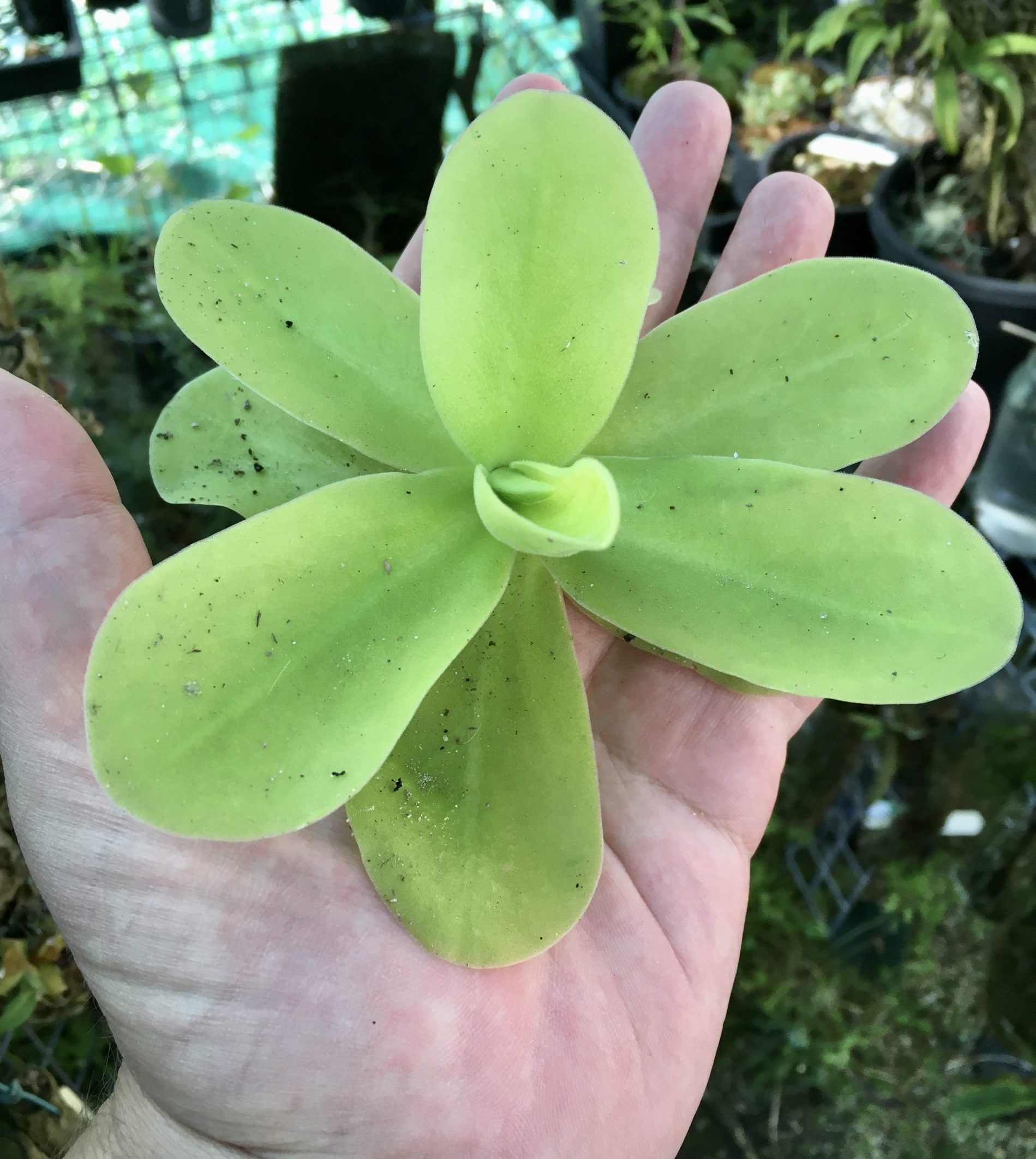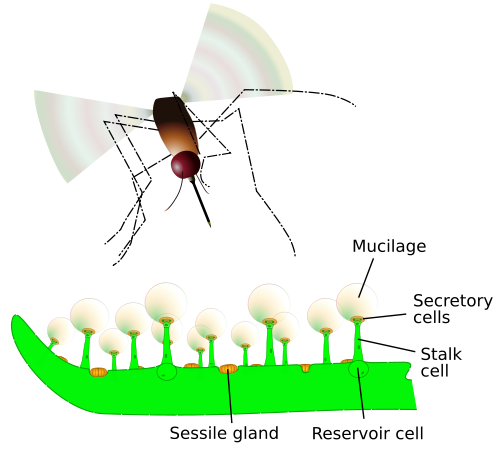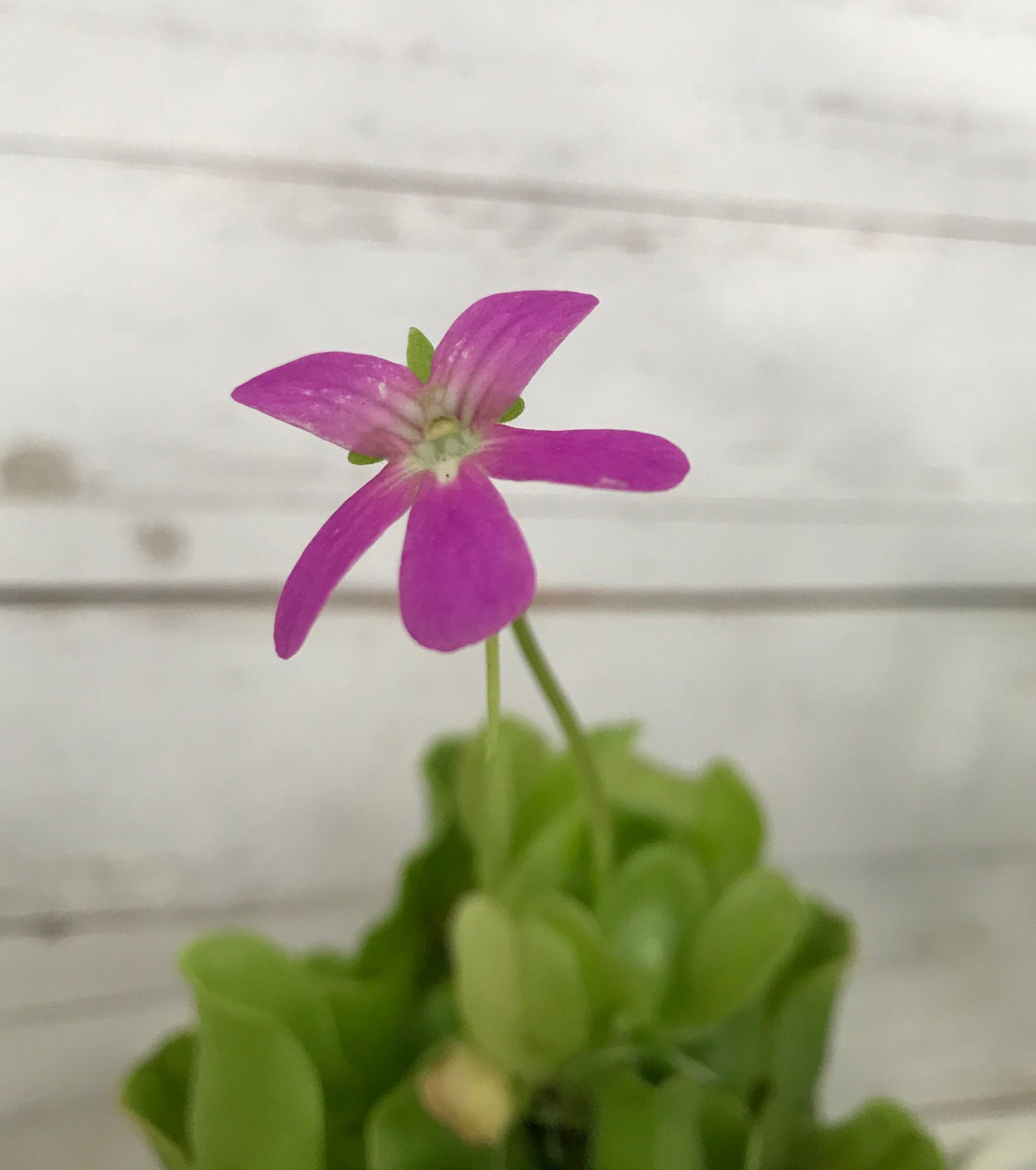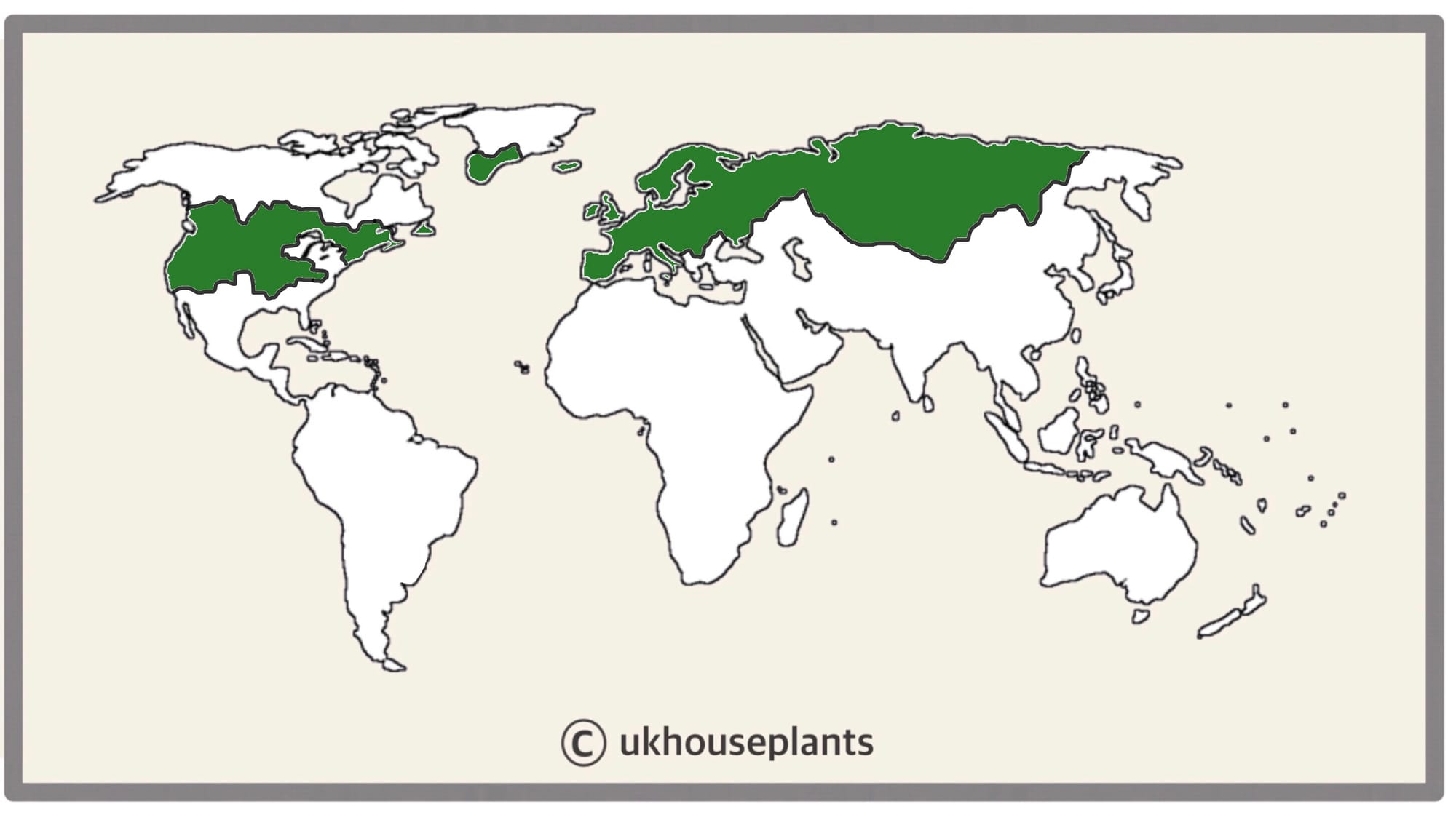
Pinguicula gigantea
Contents
- Introduction
- Top Tips
- Location, Water, Humidity & Fertilisation
- Dormancy Care
- Common Issues
- Origins, Temperature, Propagation, Repotting & Toxicity.
Need the answer to a specific plant query? Book a 1-to-1 video call with THE HOUSEPLANT DOCTOR™, the website's friendly author, to overcome and address your niggling problem! Available on iMessage, WhatsApp, Facebook Messenger & more.
Introduction
Understanding how Butterworts attract their victims is a great place to start. Many people will have a vague idea of how the mechanics work; however, the science behind this is much more enjoyable. The insect is lured onto the sticky 'platforms' via its scent of sweet nectar and shiny appearance. Once trapped in the mucilage, the digestive-acid located in the leaves' upper surface will begin its work in breaking down the victim's soft tissues - leaving nothing by its outer exoskeleton. The more the insect tries to escape, the more likely it is to become further trapped in the pads, thus providing a tasty meal for the plant.
Some species of Pinguicula will develop different-functioning leaves, depending on the season. During the dormancy period in the cooler months, it'll produce non-carnivorous leaves that act solely for photosynthesis, due to the absence of edible insects. Once the spring arrives, new mucilaginous leaves will develop from its centre, readying itself to catch and digest potential victims for nourishment. The leaves' difference can be minimal; however, some will sport reddish-toned foliage in the carnivorous stages, while developing green new growth for the cooler periods to avoid wasting vital energy on digestive enzymes.
 Copyright: Noah Elhardt
Copyright: Noah Elhardt
Top Tips & Info
- Care Difficulty - Easy
- Evenly moist soil is mandatory for a happy specimen. We recommend placing the plastic pot's base around 1cm (1/2 an inch) in water to avoid dehydration. You can purchase a plant saucer at most garden centres or online.
- Locations that offer a few hours of either morning or evening sunlight is needed for good, quality growth, with those kept in darker settings more likely to adopt crown rot.
- Butterworts are partially keen on Fungus Gnats and house flies, but you must allow it to catch its own prey to avoid poisoning or over-feeding. Do not fertilise the soil using plant feeds.
- Repotting is rare for carnivorous plants, as their root systems tend to be relatively fibrous and sparse. Only use a 'Carnivorous' labelled potting mix during a transplant, as anything else will contain too many chemicals that'll lead to root-burn. (Unfertilised coconut coir fibre is fine to use though).
- It's entirely reasonable for a small loss of leaves over the winter months, as long as there's still a few healthy leaves leftover. Once spring returns, the new juvenile growth will develop, along with a potential show of flowers.
Location & Light - 🔸🔸🔸🔸
Perfecting the amount of light a Butterwort receives is crucial for a long-lasting specimen. During the spring and summer, be sure to provide a brightly lit spot with up to three hours of direct light per day - an east or west-facing window is an excellent example. Excessive time in the direct rays will negatively affect the plant in the likes of sun-scorch and dehydration, during the warm summer months. Once the autumn kicks in, be sure to increase the exposure up to five hours a day, using either an east, south, or west-facing windowsill. Those kept in shaded areas away from the natural lighting will quickly develop crown rot, whereby the base of the plant separates from its root system. This is usually sped up by the plant's need of continuous moist soil, discussed in more detail in the following paragraph.
Which are the best types of water to use on a Pinguicula Butterwort are:
- Rainwater (dirty looking water is fine!)
- Deionised water
- Distilled water
- Water from a dehumidifier
If you don't have access to these waters, try boiling tap water and sitting it on the side for 12 hours, before running it through a Brita-style filter.
Which are the worse water Types? Do NOT Use:
- Pond water that is high in nitrates (fish excrement)
- Bottled mineral or spring water (or if it's high in lime).
Water - 🔸🔸🔸
Your specimen must sit in continual moist soil, with those left outside or near a window being monitored frequently. Butterworts naturally occur in water-laden bogs which rarely see periods of droughts, so keeping an eye for drying compost is critical for success. We'd recommend sitting the plant's base in a saucer of water, around 1cm (1/2 an inch) in depth, to provide a continuous stream of moisture. Once the plant absorbs the water, rehydrate the soil using the bottom-up method of irrigation. Under-watering symptoms include browned leaf-tips, stunted growth and rapidly declining foliage - be sure to place the pot around 1cm deep in water to counteract dehydration. Those situated in brighter areas will have their compost dry significantly quicker than others in cool, darker settings. Over-watering symptoms include a rotten crown, mouldy soil and yellow or brown lower leaves that quickly decline in health. Killing a Pinguicula by over-watering is uncommon, but aggravating factors like cold dark locations with poor air circulation could be an issue. Low temperatures aren't bad for this plant, but make sure it's exposed to enough sunlight to increase photosynthesis for counteracting the wet conditions it needs!
Humidity - 🔸🔸
Because of the continuous moist soil and use of a plastic saucer to maintain evenly moist soil, the local humidity levels will naturally be high. We wouldn't recommend misting the foliage due to the risk of botrytis or powdery mildew developing on the dying leaves.
Fertilisation -
Many people panic over what to feed their plant. Natural prey like spiders, flies, fungus gnats, and mosquitoes are the only food they should digest. Never allow it to eat something more significant than one-third of the leaf's width, as the enzymes won't be able to work entirely, thus wasting vital energy from incomplete digestion.
Keep the plant outside once the nighttime temperatures are above 10⁰C (50⁰F) so that it can catch its own prey. There's nothing better for a carnivorous plant than to allow it to breathe, digest, and photosynthesise in the fresh outdoors without human intervention. Remember to situate it in a shaded area without the risk of high temperatures, winds or direct sunlight.
Dormancy Care
The final element for a long-lasting carnivorous plant is a vital resting period during the autumn and winter months. While keeping the soil moist, reduce insect-feeds to almost none, as wild airborne prey tends to be less in numbers during this time. Reduce the ambient temperature to around 12℃ (54℉) during the night to reinforce this critical period - even a cool windowsill will be sufficient enough. If its dormancy is served well, you'll be rewarded with a flurry of juvenile growth at the start of the spring season, along with show of a purple flower!
N. B. - Those that don't serve an adequate dormancy period will show signs of weak spring growth, along with a shorter life span.
 If you provide a successful dormant period, the chance of a spring bloom is inevitable. The individual flower can last several days once opened, providing a splash of colour for the windowsill.
If you provide a successful dormant period, the chance of a spring bloom is inevitable. The individual flower can last several days once opened, providing a splash of colour for the windowsill.
Common Issues with Butterworts
If your plant develops basal collapse, it may spell the end of its life. The stem lies just below the soil line and acts like its lifeline, so any issues of rot will kill it outright. If yours has problems, be sure to take the plant out of the pot and inspect its roots. Prune away any rotten areas and check its bottom for a softened texture. If the base is still hard with areas of roots, place it in a fresh batch of 'Carnivorous' compost, keeping the foliage above the soil line. Provide a brighter location and reduce the number of waters slightly to avoid further rot. Discard the plant if it collapses.
Too little light accompanied by water-logging will cause the lower leaves to rapidly yellow and rot. Although this is a natural response to ageing on a smaller extent, persistent yellowing and a near absence of foliage should only occur during the winter. If this is the case during the height of summer, action must be taken immediately. Place the plant in a location that receives little direct sunlight out of peak hours, or outside if possible. Although it will take several weeks for the plant to start to recover, better-growing conditions with the occasional insect will significantly benefit its overall health. Other causes for yellowing leaves are sun-scorch or the use of a non-carnivorous potting mix. Butterworts must not be repotted into any other compost, as the chemicals will quickly lead to root-burn and inevitable death.
Under-developed or deformed leaves are caused by persistent under-watering or too much sunlight. Dry soil must be avoided at all times for success as they grow naturally in bog climates across the world. After a few weeks of a moist environment, better growth should start to develop.
Cold tap water will quickly damage the plant with foliage-loss and stunted growth. The cold temperatures and high levels of chloride typically found with taps water should be replaced by either rainwater or fresh bottled water. If you were to use water from the tap, help the situation by allowing it to stand for 24hrs in a non-mental container before application.
Mould developing on the soil means two things - too little light and over-watering. Despite the harmlessness, it'll prove unsightly to most gardeners and is therefore removed once known. To separate, replace the top two inches of the soil for a fresh batch of 'Carnivorous' labelled compost. Either increase the amount of light received (no direct sunlight for the first few weeks to prevent environmental shock) or decrease water frequency slightly. If the mould is accompanied by yellowing lower leaves, you may also have a case of root rot.
Origins
The name, Pinguicula, derives from a term first used by Conrad Gesner, in his 1561 work, Horti Germaniae, who commented on its glistening leaves. He described how the foliage had "fat and tender-like leaves", which when translated into modern Latin, is "propter pinguia et tenera folia". Carl Linnaeus honoured Gesner's historical texts by formally describing the genus as Pinguicula and the type species, P. vulgaris, which is the most commonly sold Butterwort in the houseplant industry. Its nickname, the Butterwort, comes from Gesner's initial description of its fat, glistening appearance.
 The Distribution of Pinguicula vulgaris.
The Distribution of Pinguicula vulgaris.
Temperature
8° - 38°C (46° - 100°F)
H1c (Hardiness Zone 11) - Houseplant-sold specimens an be grown outdoors between late spring and summer throughout most of the UK while nighttime temperatures are above 8℃ (46℉). If you decide to bring the plant outdoors, don't allow it to endure more than an hour of direct sunlight a day as it may result in sun-scorch. Regularly keep an eye out for pests, especially when re-introducing back indoors.
Spread
Over 0.10m in height and 0.3cm in width once maturity is reached. The ultimate height will take around 5 years to achieve, but can live for over 10 years in the right conditions.
Pruning & Maintenance
Remove yellow or dying leaves, and plant debris to encourage better-growing conditions. While pruning, always use clean utensils or shears to reduce the chance of bacterial and fungal diseases. Never cut through yellowed tissue as this may cause further damage in the likes of diseases or bacterial infections. Remember to make clean incisions as too-damaged wounds may shock the plant, causing weakened growth and a decline in health.
Propagation
Via Seed, Basal Offset Division & Leaf Cuttings.
Seeds (Difficult) - The only soil you can use is a 'Carnivorous' labelled compost, as other mixes will retain too many chemicals that'll burn the cases of the seeds. Set the seeds on top of the soil's surface, resisting the temptation to compact it. Maintain evenly moist compost and allow the excess water to freely drain from the pot's base to prevent water-logging. The ideal location for successful germination is in a bright, indirect setting with temperatures above 18℃ (64℉) with bottom-heat. Keep the pot in a transparent bag to provide a stable level of humidity, along with longer-lasting soil moisture. Germination may take up to three months, so don't discard any unsuccessful seeds until this threshold has been surpassed. Remove the bag once the seedlings produce their second leaf and then split them into their own 5cm (2 inches) pots after a further month.
Basal Offset Division (Moderate) - Your plant will produce several offsets that can be separated once they have a sufficient root system. If possible, water the soil 24hrs before the main event to reduce the risk of transplant shock, when its dry root systems are over-fingered. Take the plant out of its pot and place your fingers close to the nodal junction - compost may have to be removed for better access. Push the chosen offset downwards until you hear a snap. Separate the foliage and its root system away from the mother plant, mentally noting the high risk of damage. Transplant in the appropriate sized pot with a fresh batch of 'Carnivorous' soil. Maintain evenly moist soil and situate it in a bright, indirect location away from any direct sunlight. After ten weeks, treat it like a healthy specimen, following the care tips above!
Leaf Cuttings (Moderate) - Leaves that are halfway along the plant's base have the most potential due to its size and maturity. Gently place your fingers between the mother's stem and the leaf's base, pulling it downwards until you hear a snap. Ensure the wound is wholly intact with no damage, as a bruise or tear will result in unsuccessful propagation. Set the leaf's lower third in a bed of moist 'Carnivorous' compost for root growth. Provide a bright setting with temperatures around 18°C (64°F) with an absence of drying soil or excessive sunlight. New leaves should emerge within six to twelve weeks, thus signalling the start of its independent life!
Flowers
Blooms will appear in the spring or summer, during the warmer temperatures of the year. Most Butterworts will produce one or two flowers, lasting several days at a time. There isn't much you can do to stimulate a show of colour, as the use of flower-inflicting nutrients (like potassium) can't be used for chemical burn reasons on its roots.
Repotting
Repot every three or four years in the spring, using only a 'Carnivorous' labelled compost and the next sized pot with adequate drainage. Hydrate the plant 24hrs before tinkering with the roots to prevent the risk of transplant shock. If you're still unsure of what to do, never hesitate to send us an email or direct message to get our expert advice on transplantation. Never use any other compost as the chemicals typically found in these soils will burn the roots, killing the plant outright.
Book a 1-to-1 video call with THE HOUSEPLANT DOCTOR™ if you'd like a personal guide to repotting your houseplant. This will include recommending the right branded-compost and pot size, followed by a live video call whilst you transplant the specimen for step-by-step guidance and answer any further questions!
Pests & Diseases
Keep an eye out for aphids, blackfly, soil mites & root mealybugs that'll locate themselves in the cubbyholes and undersides of the leaves, with the exception of the latter two in the soil. Common diseases associated with Butterworts are root rot, leaf-spot disease, botrytis, powdery mildew & southern blight - click here to learn more about these issues.
Toxicity
Not known to be poisonous when consumed by pets and humans. If large quantities are eaten, it may result in vomiting, nausea and a loss of appetite.
Retail Locations
Blue Diamond, Dobbies, Online Stores.
Book a 1-to-1 Call with THE HOUSEPLANT DOCTOR™
If you need further advice with your houseplants, book an advice call with ukhouseplants' friendly and expert writer today! This can be done via a video or audio call on most apps, including Facebook, FaceTime & Skype. A ten-minute call costs £5.99 (US$7), or £15.99 for thirty minutes. You can ask multiple questions, including queries on plants, pests, terrariums, repotting advice and anything in between. Please consider supporting this service to keep ukhouseplants thriving!